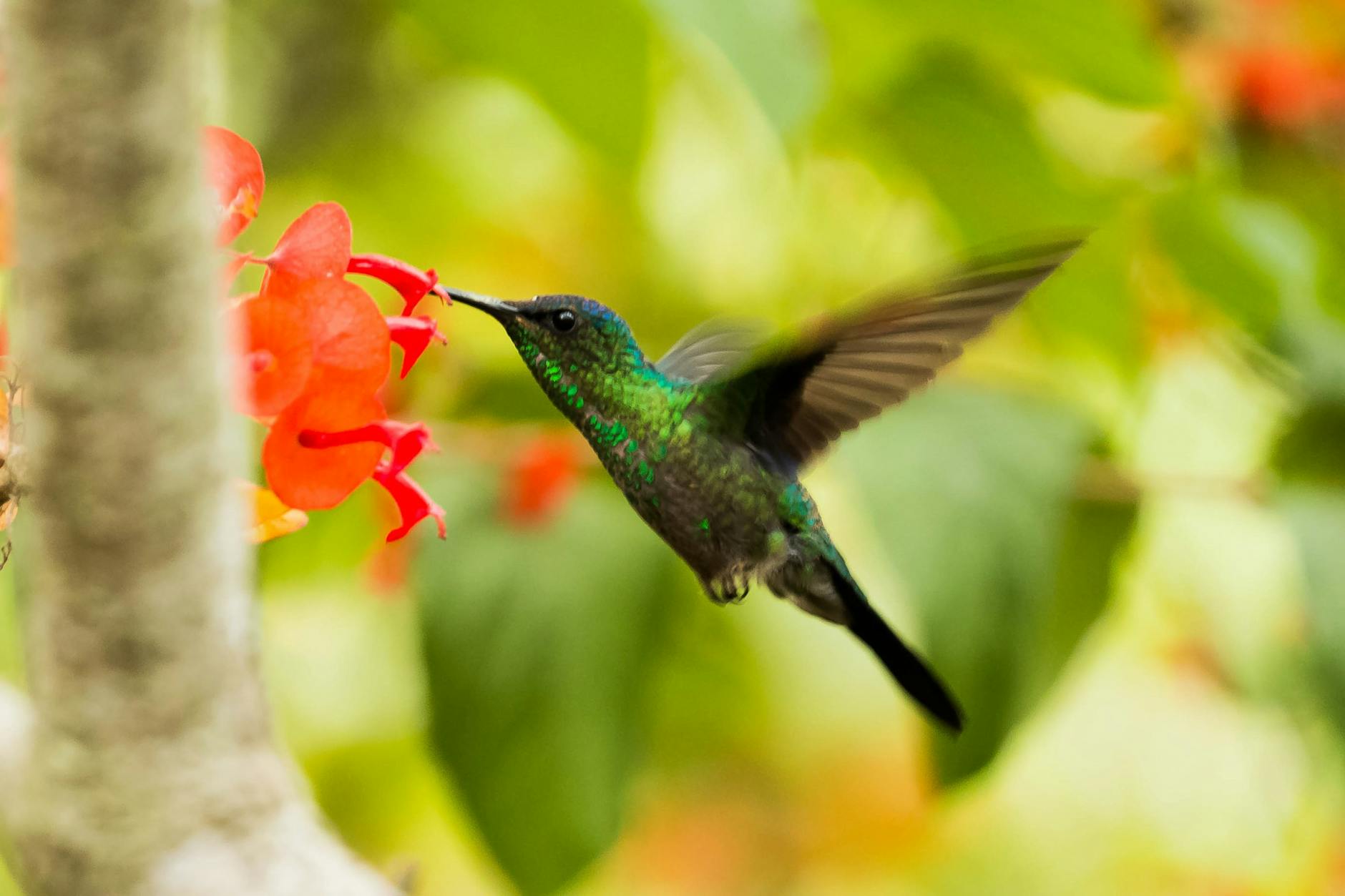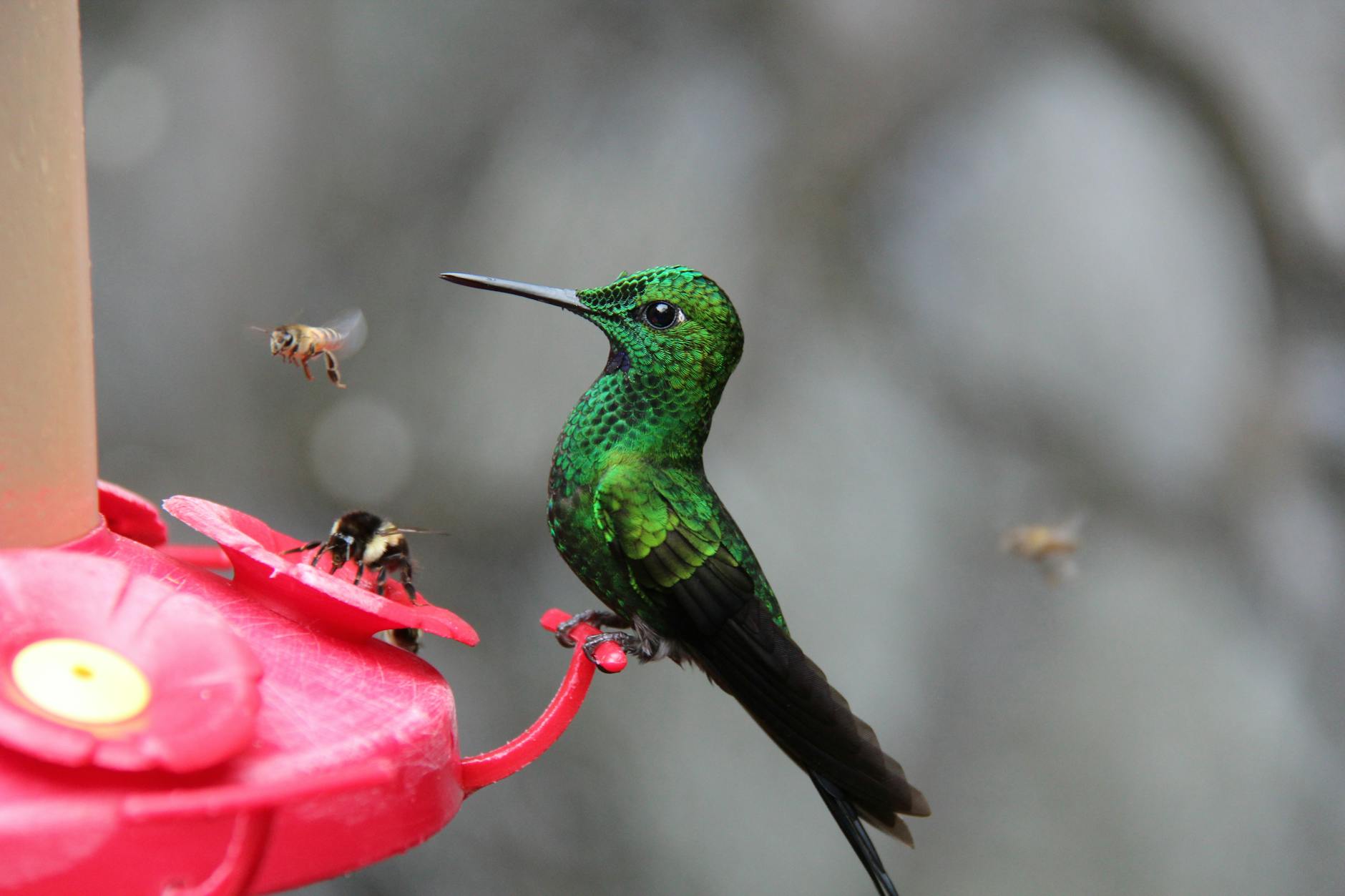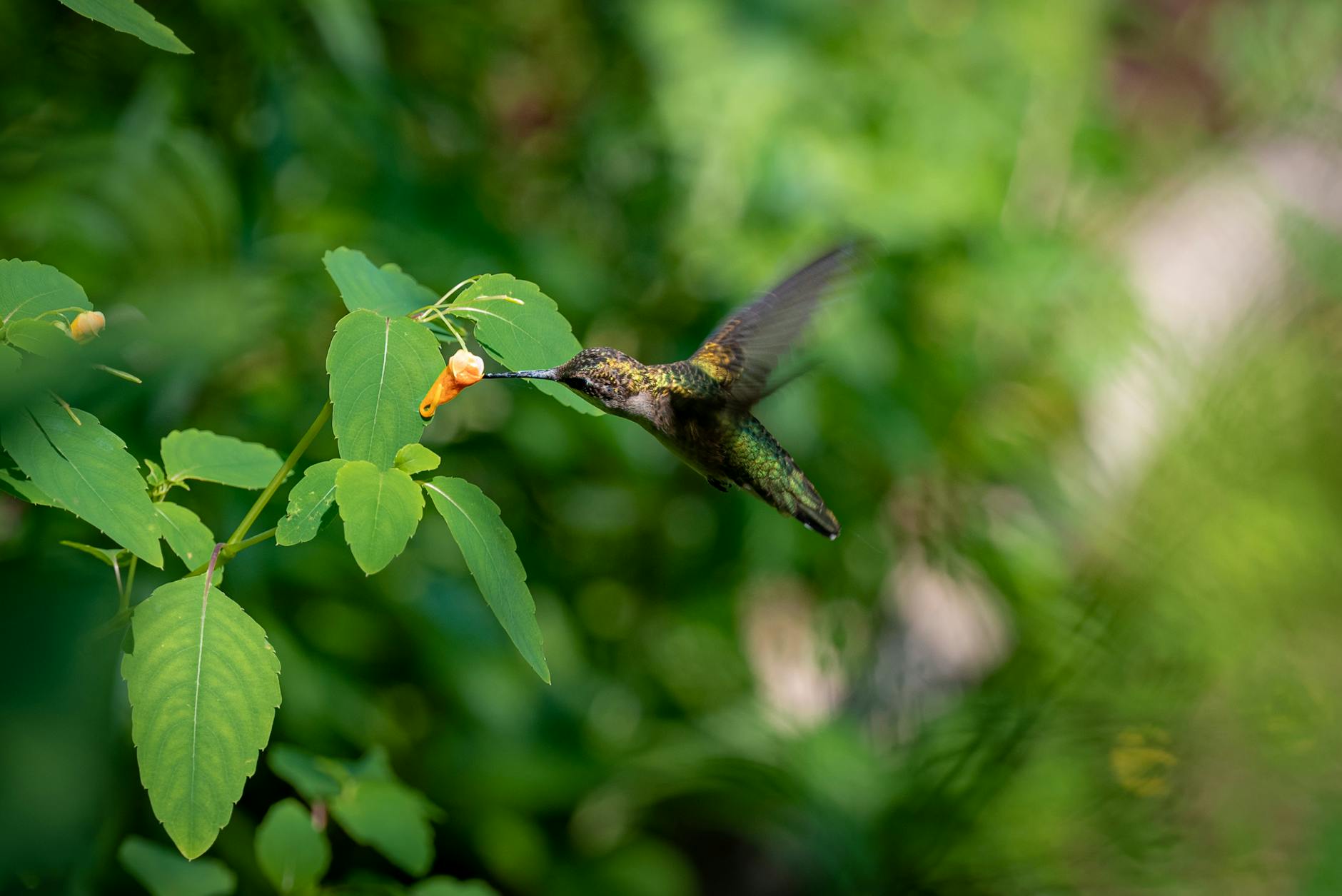How Climate Change is Threatening Hummingbirds and Their Ecosystems
Hummingbirds aren’t just beautiful; they’re essential. These tiny birds pollinate flowers and sustain ecosystems. But climate change is disrupting their survival. Rising temperatures, loss of habitats, and altered migration patterns are putting their future at risk. This growing crisis doesn’t just affect hummingbirds—it has ripple effects across the ecosystems they support. Understanding this impact is key to protecting both biodiversity and balance in nature.
Understanding Hummingbirds
Hummingbirds are more than just a charming sight in nature. These remarkable creatures are designed for endurance, precision, and survival. Their unique physical traits, ecological contributions, and migration habits reveal how crucial they are to ecosystems that depend on them.
Physical Characteristics and Adaptations

Photo by Pixabay
Hummingbirds are true marvels of engineering, small but perfectly adapted to their environment. Their lightweight skeletons, with hollow bones, minimise weight to enhance their extraordinary flight abilities. These birds are the only ones capable of hovering in place and flying backward, thanks to their ball-and-socket shoulder joints.
The long, narrow beak and extendable, tube-like tongue are tools designed to extract nectar from flowers. Their wings beat up to 80 times per second, generating enough lift for quick movements from flower to flower. Even their tiny feet are built for efficiency—they perch rather than walk, conserving energy. You can learn more about their incredible adaptations here.
Ecological Roles
Hummingbirds are more than just pollinators; they are vital players in the food chain. They transfer pollen from flower to flower while feeding on nectar, enabling plant reproduction. Some plants even rely exclusively on hummingbirds for pollination, especially in areas where insects are less effective due to environmental conditions. This interaction supports biodiversity by helping maintain plant populations.
These birds also serve as prey to larger animals, linking multiple levels of the food web. Their consumption of small insects and spiders for protein provides an ecological balance—ensuring pests are kept in check. Their role in ecosystems underlines the importance of understanding and protecting them. Explore their contributions further here.
Migration Patterns
Hummingbird migration is a fascinating phenomenon. These tiny birds undertake journeys spanning thousands of miles, often between Central America and North America. They signal the changing of seasons, moving north in spring to breed and south in autumn to escape the cold. Ruby-throated hummingbirds, for instance, fly non-stop for up to 18 hours across the Gulf of Mexico during their migration.
Their migration paths, influenced by temperature changes and food availability, are essential for survival. Yet, these patterns are being disrupted by climate change, which alters blooming schedules and ecosystems along their routes. To better understand their migratory habits, visit this resource.
This exceptional resilience and adaptability highlight why hummingbirds are critical to biodiversity, despite their small size. Protecting them means preserving the balance of the ecosystems they sustain.
Effects of Climate Change on Hummingbird Habitats
As temperatures climb and ecosystems shift, hummingbirds are facing serious threats to their survival. This section explores key impacts of climate change on their habitats, focusing on loss of breeding ranges, shifting habitats due to rising temperatures, and disruptions to their critical food sources.
Loss of Breeding Range

Photo by Robert Acevedo
Projections show a dramatic contraction in the breeding range of many hummingbird species by 2080. These changes are directly tied to warming temperatures and habitat destruction. Take the rufous hummingbird, for instance. By 2080, its breeding grounds are expected to shift further north, potentially reducing suitable territories to just a fraction of what exists today. This poses significant risks as hummingbirds may struggle to find nesting sites and food sources in unfamiliar areas.
Several species may also find themselves squeezed out of both old and new habitats, as competition with other species increases. This cascading effect could disrupt their breeding cycles, directly impacting population numbers. Resources such as Audubon’s research provide more details on these alarming trends.
Temperature Changes and Habitat Shifts
Temperature fluctuations are reshaping the very ecosystems that hummingbirds depend on. As global temperatures rise, the availability of nesting and foraging sites is diminishing. For example, high-altitude species like those in the Monteverde Cloud Forest of Costa Rica are losing their habitats due to upward shifts in vegetation zones. These tiny birds may need to migrate higher for food and shelter, but there’s only so much altitude to go.
Hummingbirds are uniquely impacted by these shifts because they are highly specialised to their environments. A warming climate may lead to habitat fragmentation, shrinking the lush forests and meadows they rely on. According to scientific studies, hummingbirds struggling to adapt to higher elevations often face reduced oxygen levels and fewer food options, further straining their populations.
Impact on Food Sources
Climate change doesn’t only affect the birds—it also impacts the plants they depend on. The flowering times of nectar-providing plants are shifting, creating a mismatch between when flowers bloom and when hummingbirds arrive. This phenomenon, often called phenological mismatch, can leave hummingbirds without their primary energy source during critical migration and breeding periods.
Species like the ruby-throated hummingbird, which relies on synchronised migration and blooming cycles, are particularly vulnerable. Rising temperatures also accelerate the flowering of some plants, causing them to wither before the birds arrive. Learn more about this dynamic interaction and its implications for ecosystems.
Additionally, extreme weather events linked to climate change, such as storms or droughts, can decimate hummingbird food sources over large areas. As their primary sources of food disappear, hummingbirds are forced to expend more energy searching for alternatives, leaving them weaker and less likely to survive. This cycle underscores the urgent need for conservation efforts.
These threats together showcase the wide-reaching effects climate change has not just on the birds themselves, but on the delicate ecosystems in which they exist. Preserving and restoring hummingbird habitats can mitigate some of these crises, but immediate action is essential.
Behavioural Changes in Hummingbirds
Hummingbirds are renowned for their agility and energy, but climate change is testing their limits. As their ecosystems shift, these resilient birds must adapt to survive. Below, we explore two major behavioural changes linked to climate change: shifts in feeding habits triggered by extreme weather and evolving migration patterns.
Adaptation to Extreme Weather

Photo by Djalma Paiva Armelin
Intense weather conditions, like prolonged heatwaves or heavy rains, are reshaping how hummingbirds feed. These birds need high-energy food to support their accelerated metabolism. However, extreme weather disrupts nectar availability, forcing hummingbirds to adjust their foraging routines.
- Heatwaves: During prolonged heatwaves, species like the Anna’s hummingbird reduce energy-demanding behaviours, such as defending territory. This trade-off allows them to regulate body temperature and save energy. Studies show that birds may shift feeding activity to cooler hours of the day, such as early mornings or evenings, to minimise heat exposure. Explore more on this topic here.
- Floods and Storms: Heavy rainfall washes away flowers, reducing nectar sources for days. Hummingbirds are then pushed to fly longer distances, wasting energy searching for alternative feeding spots. The increased effort can directly impact their body condition and survival rates.
These behavioural shifts are nature’s way of balancing survival. However, with extreme weather events becoming more frequent, the question remains: how much adaptation is too much?
Shift in Migration Timing
Climate change is also altering the timing of hummingbird migrations. Traditionally, seasonal cues such as temperature and food availability guide these birds’ long journeys. However, shifting climates are throwing off these signals, leading to earlier—or delayed—departures.
For instance, some species now migrate earlier in spring to align with the earlier blooming of flowers. While this might seem like an advantage, it creates a new set of challenges:
- Mismatched Resources: Early arrivals may face a scarcity of fully bloomed flowers, leaving them stranded with limited food. This mismatch, called phenological asynchrony, can stunt reproductive success.
- Risky Journeys: Warming temperatures don’t always mean stable conditions. Late-spring cold snaps can surprise early migrants, exposing them to harsh weather. These unpredictable conditions strain their already high energy needs. For details on how climatic shifts impact these routes, visit this resource.
Changes in migration timing disrupt the rhythm of ecosystems. Mistimed movements affect not just the birds but also the plants and animals that rely on their interactions. These timing shifts highlight the delicate balance hummingbirds maintain with their environment, now under threat from climate disruption.
Understanding these behavioural changes provides essential clues for conservationists aiming to support their survival. Left unchecked, these fragile adaptations may not be enough against the relentless impacts of climate change.
Consequences of Declining Hummingbird Populations
As hummingbird populations decline, the natural equilibrium of ecosystems faces significant disruptions. These tiny pollinators play an outsized role in maintaining biodiversity and plant reproduction. Without them, the delicate balance of many ecosystems could unravel.
Impact on Pollination

Photo by Dick Scholten
Hummingbirds aren’t just casual visitors to flowers; they’re vital pollinators. These birds feed on nectar, transferring pollen from flower to flower, spurring plant reproduction. Without them, flowering plants that depend solely on hummingbird pollination face an uncertain future.
Many plants have evolved alongside hummingbirds, with some species relying exclusively on them for pollination. As their numbers dwindle, these plants struggle to reproduce, leading to cascading effects across ecosystems. For example, hummingbirds support the survival of native wildflowers in North and South America. A decline in these mutualistic relationships could mean less food for other wildlife and a weaker ecosystem.
Want to learn more about their transformative role in pollination? Check out this resource.
Ecological Domino Effect
When hummingbirds disappear, the effects ripple outward. Like pulling a single thread from a woven fabric, their absence unravels interconnected ecological systems.
- Loss of biodiversity: Plants dependent on hummingbirds may fade, reducing biodiversity within habitats. This, in turn, impacts other creatures reliant on those plants for food or shelter.
- Altered food webs: Hummingbirds also serve as prey to certain birds and mammals. A drop in their population creates gaps in food webs, potentially leading to overpopulation of pests or hunger for predators.
- Impact on agriculture: Many fruits and seeds humans rely on stem from plants pollinated by birds, including hummingbirds. Their population collapse could indirectly threaten agricultural productivity.
For an in-depth look at the cascading ecological impacts, explore this article.
Hummingbirds are more than delicate creatures; they are ecological linchpins holding many systems together. A world without these birds would face harsher environments, reduced plant diversity, and fewer resources for animals and humans alike.
Conservation Efforts and Strategies
Climate change poses a significant threat to hummingbirds, but efforts to conserve these tiny creatures are already underway. Below, we explore how habitat preservation and ongoing research help safeguard their future.
Habitat Preservation

Photo by Chris F
Preserving natural habitats is one of the most effective ways to protect hummingbirds. By focusing on the spaces where these birds live, breed, and feed, various initiatives aim to counter habitat loss caused by urbanisation, deforestation, and climate change.
- Planting Native Flora: Organisations like Pollinator Partnership encourage communities to plant native nectar-rich flowers. These plants offer the food supply hummingbirds need during their migration and breeding seasons.
- Creating Protected Areas: Conservation groups are working to establish reserves specifically for hummingbirds. These include protected corridors that support their migratory patterns.
- Urban Green Spaces: Even small-scale projects in urban areas, like hummingbird gardens and feeders, provide essential food and shelter for these birds.
Efforts like these create sustainable environments, ensuring that hummingbirds have natural refuges amidst the challenges posed by a changing world.
Research and Monitoring
Understanding how hummingbirds respond to environmental stressors is vital for their conservation. Research and continuous monitoring allow scientists to track population trends and identify species at risk.
- Monitoring Projects: Organisations such as the Hummingbird Monitoring Network actively observe changes in population sizes. These insights help determine how climate shifts disrupt their migration, breeding, and feeding patterns.
- Species-specific Studies: Research initiatives delve into how particular species, like the rufous or ruby-throated hummingbirds, cope with climate-induced challenges. For instance, studies monitor their habitat ranges as they shift northward.
- Community Involvement: Citizen scientists play a critical role in collecting data. Platforms like Audubon’s Hummingbird Study encourage enthusiasts to record sightings, contributing valuable information to long-term population studies.
This data-driven approach not only highlights the challenges but also informs strategies like habitat restoration and targeted conservation efforts.
Through habitat preservation and diligent research, we ensure these delicate yet vital birds have a fighting chance against climate change’s many threats.
Conclusion
Protecting hummingbirds from climate change’s growing impact isn’t just about saving one species; it’s about preserving the balance of ecosystems they sustain. These tiny birds, with their remarkable behaviours and critical ecological roles, are among the first casualties of rising temperatures and habitat disruptions. As breeding ranges contract, food sources vanish, and migration routes shift, hummingbirds face significant challenges. Their resilience is admirable, but it has its limits.
The future of hummingbirds depends on action today. Their decline points to larger environmental issues, such as habitat destruction and climate instability, that affect countless species. Whether by supporting habitat preservation, gardening with native plants, or promoting research, each effort helps safeguard these vital pollinators. To learn more about hummingbird conservation, explore resources like the Hummingbird Society or Pollinator Partnership.
By addressing climate change and supporting conservation strategies, we not only ensure the survival of hummingbirds but also protect the intricate web of life they help sustain. Their presence in our world is more than a natural wonder—it’s a sign of a healthy planet we all share.










